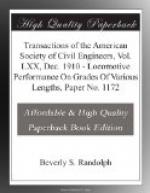Oil Treatment.—The temperature being maintained at 160 deg. Fahr., the cylinders shall be promptly filled with creosote oil at a temperature as high as practicable (about 100 deg. Fahr.). The oil shall be maintained at a pressure ranging from 100 to 120 lb., as experience and measurements must determine the length of time the oil treatment shall continue, so that the required amount of oil may be injected.
After the required amount of oil is injected, the superheated steam shall be shut off, the oil let out, the cylinders promptly opened at each end, and the timber immediately removed from the cylinder.
In the erection of timbers the sap side must be turned up, and framing or cutting of timbers shall not be permitted, if avoidable. All cut surfaces of timbers shall be saturated with hot asphaltum, thinned with creosote oil. The heads of piles when cut shall be promptly coated with the hot asphaltum and oil, even though the cut-off be temporary.
METHOD OF TESTING.
The tests were made on a Riehle 100,000-lb. machine in the Experimental Engineering Laboratory of Tulane University of Louisiana. The machine is provided with a cast-iron beam for cross-bending tests. The distance between supports was 12 ft. The method of support was as follows: Each end of the beam was provided with a steel roller which rested on the cast-iron beam of the testing machine, while above the roller, and, directly under the beam tested, there was a steel plate 6 by 8 in. in area and 1 in. thick. The area was sufficiently great to distribute the load and prevent the shearing of the fibers of the wood. The head of the Riehle machine is 10 in. wide. A plate, 3/8 in. thick, 6 in. wide and 18 in. long, was placed between the head of the machine and the beam tested.
[Illustration: Fig. 1.—DEFLECTON curves beam I]
[Illustration: Fig. 2.—DEFLECTON curves beam II]
TABLE 1.—SUMMARY OF RESULTS OF TRANSVERSE TESTS OF BEAMS AT TULANE UNIVERSITY, FEBRUARY 10TH TO MARCH 2D, 1909.
Columns in table:
1. Number of beam. 2. Top or butt of log. 3. Width, in inches. 4. Height, in inches. 5. I = (bh^3)/12 6. Actual at elastic limit. 7. Maximum. 8. At elastic limit. 9. Maximum. 10. At elastic limit. 11. E = (Pl^3)/(48dI) 12. Weight, in pounds per cubic foot.
=======================================================
====================+




